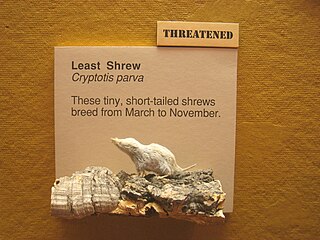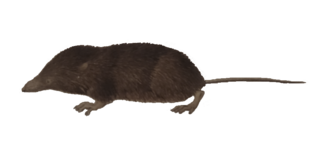
The red-toothed shrews of the subfamily Soricinae are one of three living subfamilies of shrews, along with Crocidurinae and Myosoricinae. In addition, the family contains the extinct subfamilies Limnoecinae, Crocidosoricinae, Allosoricinae and Heterosoricinae. These species are typically found in North America, northern South America, Europe and northern Asia. The enamel of the tips of their teeth is reddish due to iron pigment. The iron deposits serve to harden the enamel and are concentrated in those parts of the teeth most subject to wear. Members of the genera Chimarrogale, Nectogale, Neomys (Nectogalini) and some members of Sorex (Soricini) are known as water shrews, due to having a semi-aquatic lifestyle.

The genus Cryptotis is a group of relatively small shrews with short ears, which are usually not visible, and short tails, commonly called small-eared shrews. They have 30 teeth and are members of the red-toothed shrew subfamily. Since 1992, Neal Woodman at the United States National Museum has been in the process of revising the genus. To date, this has resulted in an increase in the number of species from 12 to 30.

The piebald shrew is a shrew found in the Turan Lowland east of the Caspian Sea in Iran, Turkmenistan and Uzbekistan.
Endangered mammals of India are the mammal species in India that are listed as threatened in the International Union for Conservation of Nature and Natural Resources (IUCN) Red List of Threatened Animals

The long-clawed shrew is a species of shrew. An adult long-clawed shrew has a weight of less than 20 grams (0.71 oz) and a body length of 54 millimetres (2.1 in) to 97 millimetres (3.8 in), with a tail of 40 millimetres (1.6 in) to 53 millimetres (2.1 in). It is distributed through the uplands of northeastern Asia, including northeastern North Korea.

Laxmann's shrew, or the masked shrew, is a species of shrew. Its range extends from northern Scandinavia and the Baltic to the Sea of Japan, including Hokkaidō, Sakhalin, and the Korean Peninsula. It favours mountain forests but is sometimes found in tundra and moorland, and also in lowland areas as well. It avoids cultivated land.

The blackish small-eared shrew is a species of shrew in the family Soricidae. It is found in parts of Costa Rica, El Salvador, Guatemala, Honduras, Mexico, and Panama. An example specific habitat is the Petenes mangroves of the Yucatán.

The De Winton's shrew is a species of mammal in the family Soricidae. It is endemic to China.

The long-tailed brown-toothed shrew is a species of mammal in the family Soricidae. It is found in China, India, Myanmar, Nepal, and Vietnam.

The long-tailed mountain shrew is a species of mammal in the family Soricidae. It is found in China, Myanmar, Nepal, and Vietnam.

The Lowe's shrew is a species of mammal in the family Soricidae. It is found in China, Myanmar, Thailand, and Vietnam.

The Assam mole shrew is a species of red-toothed shrew endemic to northeast India.

The Eastern Cordillera small-footed shrew is a species of mammal in the family Soricidae. It is endemic to Colombia, where it is known from the western slopes of the central Cordillera Oriental at elevations from 1,300 to 2,715 m. It resembles C. colombiana. The species is only known from four individuals collected at two localities, the most recent record being from 1925.

The Colombian small-eared shrew is a species of mammal in the family Soricidae. It is endemic to Colombia, where it is known from the Cordillera Central in Antioquia Department at elevations from 1,750 to 2,800 m. It is found in montane forest and cultivated areas. It resembles C. brachyonyx.

Soriculus is a genus of shrew native to Asia. Along with several fossil species, the only extant member of the genus is the Himalayan shrew, as other extant species have now been transferred to other genera.
















